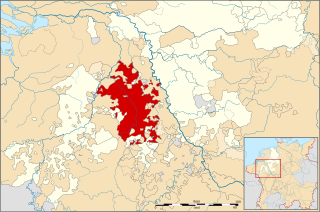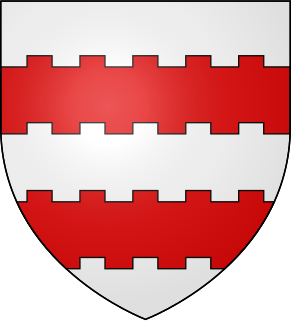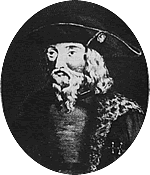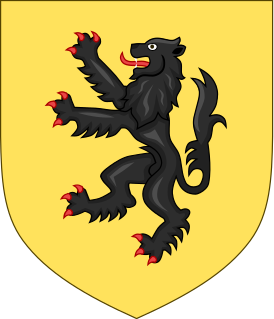Related Research Articles

Guelders or Gueldres is a historical county, later duchy of the Holy Roman Empire, located in the Low Countries.

The Duchy of Jülich comprised a state within the Holy Roman Empire from the 11th to the 18th centuries. The duchy lay west of the Rhine river and was bordered by the Electorate of Cologne to the east and the Duchy of Limburg to the west. It had territories on both sides of the river Rur, around its capital Jülich – the former Roman Iuliacum – in the lower Rhineland. The duchy amalgamated with the County of Berg beyond the Rhine in 1423, and from then on also became known as Jülich-Berg. Later it became part of the United Duchies of Jülich-Cleves-Berg.

Geldern is a city in the federal German state of North Rhine-Westphalia. It is part of the district of Kleve, which is part of the Düsseldorf administrative region.

Maria van Arkel was the only daughter and heiress of Lord John V of Arkel and Joanna of Jülich. She inherited the title to Gelderland from her maternal uncle, Duke Reginald IV, and her son became Arnold, Duke of Gelderland. She was the paternal grandmother of Mary of Guelders, who became Queen of Scots.

Arnold of Egmond was Duke of Guelders, Count of Zutphen.

La Marck was a noble family, which from about 1200 appeared as the counts of Mark.

The First War of the Guelderian Succession was a battle for the throne of the Duchy of Guelders that raged between 1371 and 1379.

This article is about the rulers of the historical county and duchy of Guelders.

Reginald II of Guelders, called "the Black", was Count of Guelders, and from 1339 onwards Duke of Guelders, and Zutphen, in the Low Countries, from 1326 to 1343. He was the son of Reginald I of Guelders and Marguerite of Flanders.
Reginald III was Duke of Guelders and Count of Zutphen from 1343 to 1361, and again in 1371. He was the son of Reginald II of Guelders and of Eleanor of Woodstock, daughter of Edward II of England.

William was Duke of Guelders, as William I, from 1377 and Duke of Jülich, as William III, from 1393. William was known for his military activities, participating in the Prussian crusade five times and battling with neighbors in France and Brabant throughout his rule. His allies included Holy Roman Emperors, Charles IV and Wenceslaus, Richard II of England, and Conrad Zöllner von Rothenstein, the Grand Master of the Teutonic Knights. During his reign the duchies of Guelders and Jülich were temporarily unified.
Katherine of Bavaria, was the eldest child of Albert I, Duke of Bavaria and his first wife Margaret of Brieg. She was Duchess of Guelders and Jülich by her marriage to William I of Guelders and Jülich.

Upper Guelders or Spanish Guelders was one of the four quarters in the Imperial Duchy of Guelders. In the Dutch Revolt, it was the only quarter that did not secede from the Habsburg monarchy to become part of the Seven United Netherlands, but remained under Spanish rule during the Eighty Years' War.

Reginald IV was the second duke to rule both Guelders and Jülich
William II, Duke of Jülich was the second Duke of Jülich and the sixth William in the House of Jülich. He was the second son of William I of Jülich and Joanna of Hainaut.
Adolf, Duke of Jülich-Berg, was the first Duke of the combined duchies of Jülich and Berg. He was the son of William VII of Jülich, 1st Duke of Berg and Anna of the Palatinate.
Edward was the duke of Guelders and count of Zutphen from 1361 until 1371. He was the youngest son of Duke Reginald II of Guelders and his second wife, Eleanor of Woodstock, daughter of King Edward II of England.

The Hours of Maria d'Harcourt is an illuminated book of hours produced in 1415 in Arnhem and Nijmegen in the Duchy of Guelders. It follows the Roman liturgy, with 6 full-page miniatures and 86 smaller miniatures, with stylised borders. It is held partly by the Staatsbibliothek zu Berlin and partly by the Österreichische Nationalbibliothek.

The House of Jülich, German: Haus von Jülich, was a noble House in Germany, operating from the 12th to the 16th century. Its members were initially counts of Jülich, then promoted to dukes of Jülich. By marriage they acquired the duchy of Gelders, which eventually passed to the House of Egmond. They again acquired the counties of Berg & Ravensberg by marriage, and as counts of Berg were elevated to the dukes of Berg; the House became extinct when in 1511 the last male member died and in 1543 the last female died.
Elisabeth of Brunswick-Lüneburg was a Duchess of Brunswick-Lüneburg by birth and by marriage Duchess of Guelders.